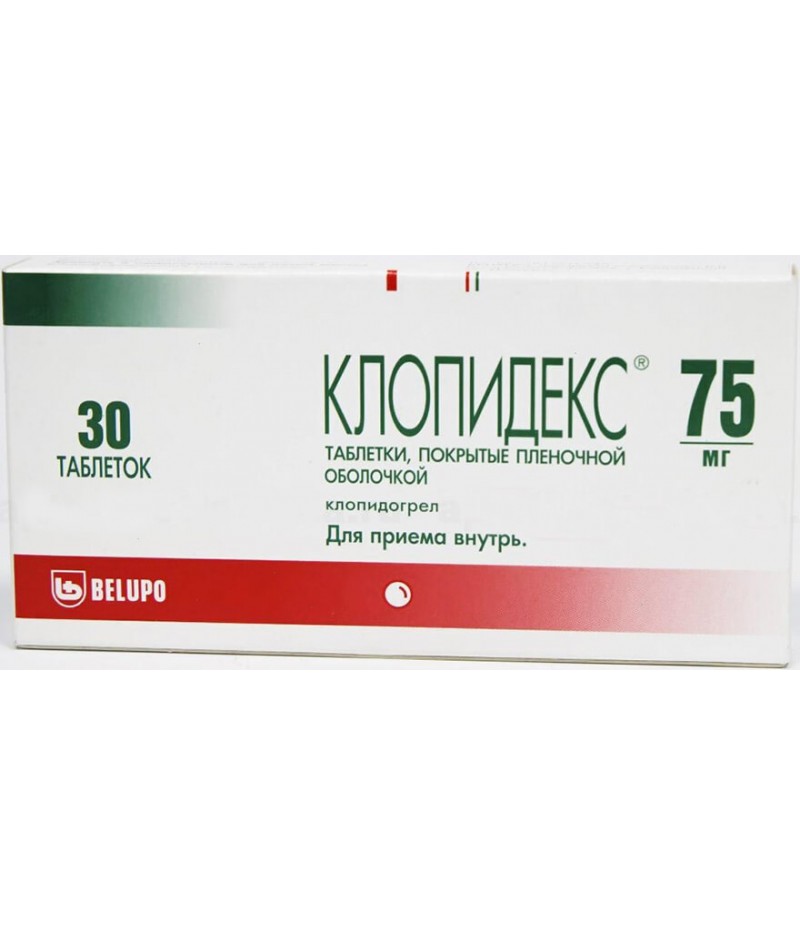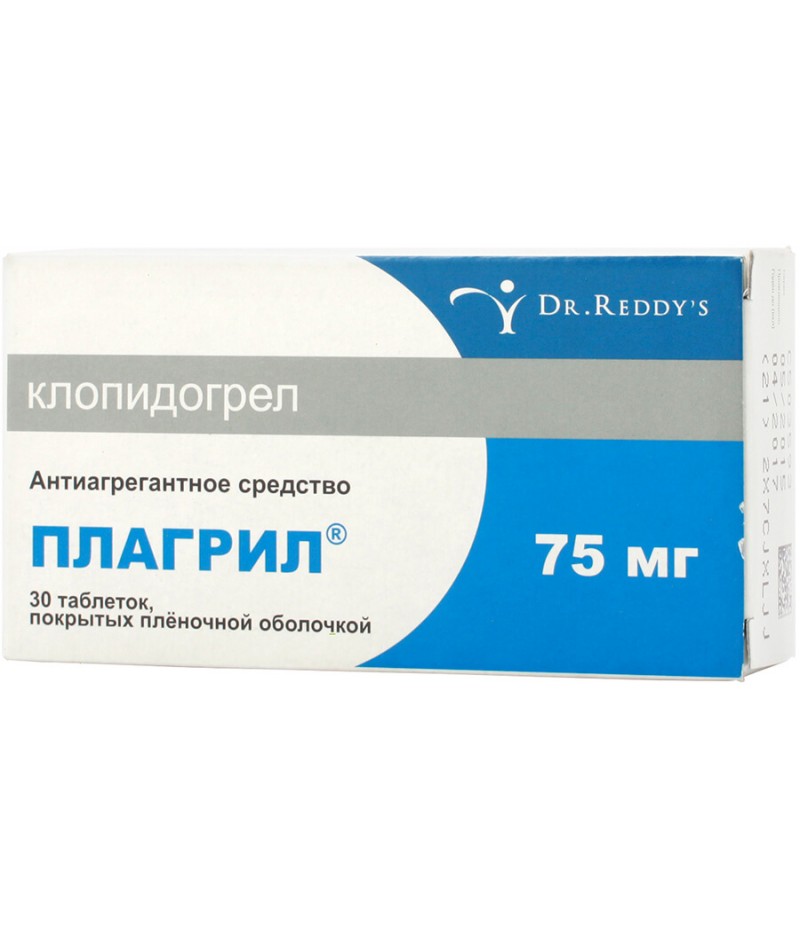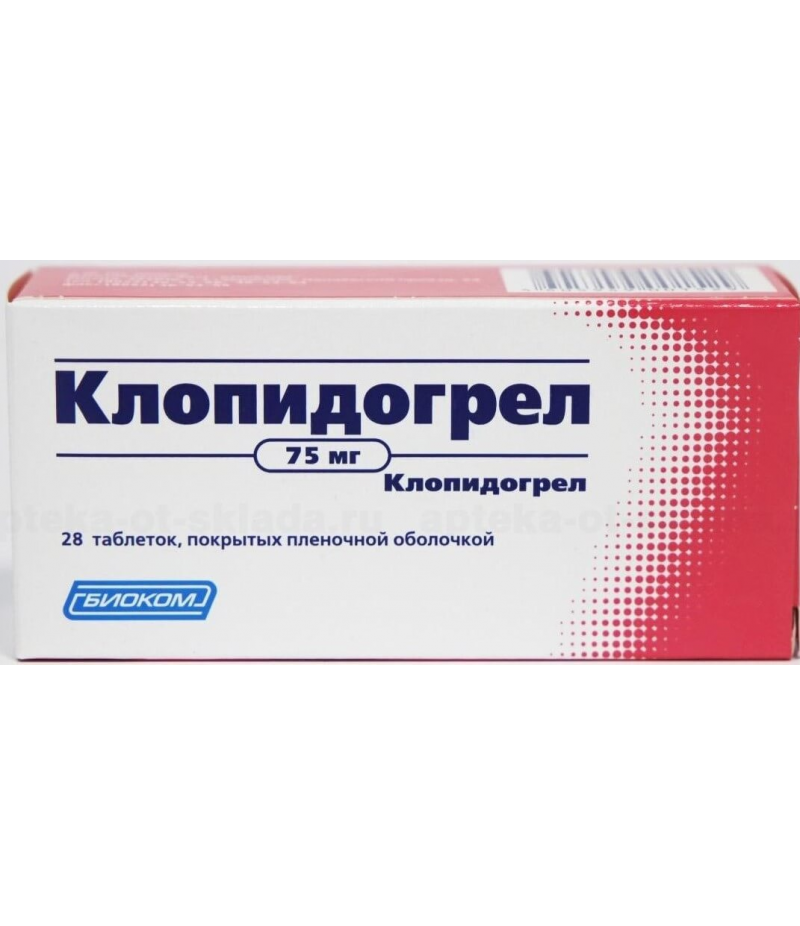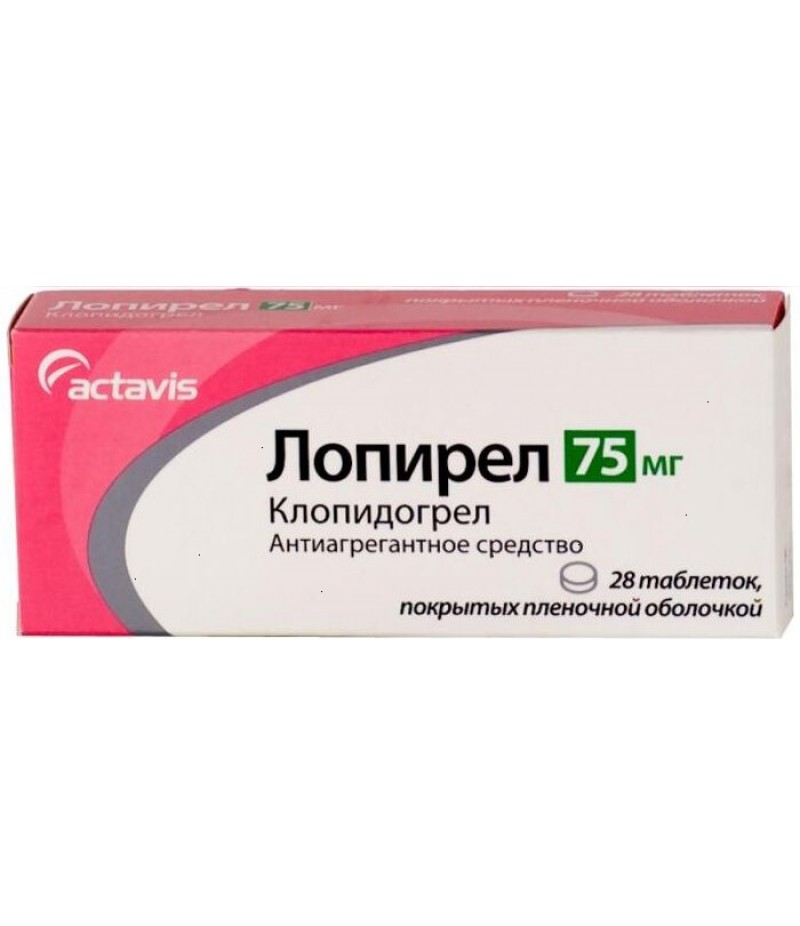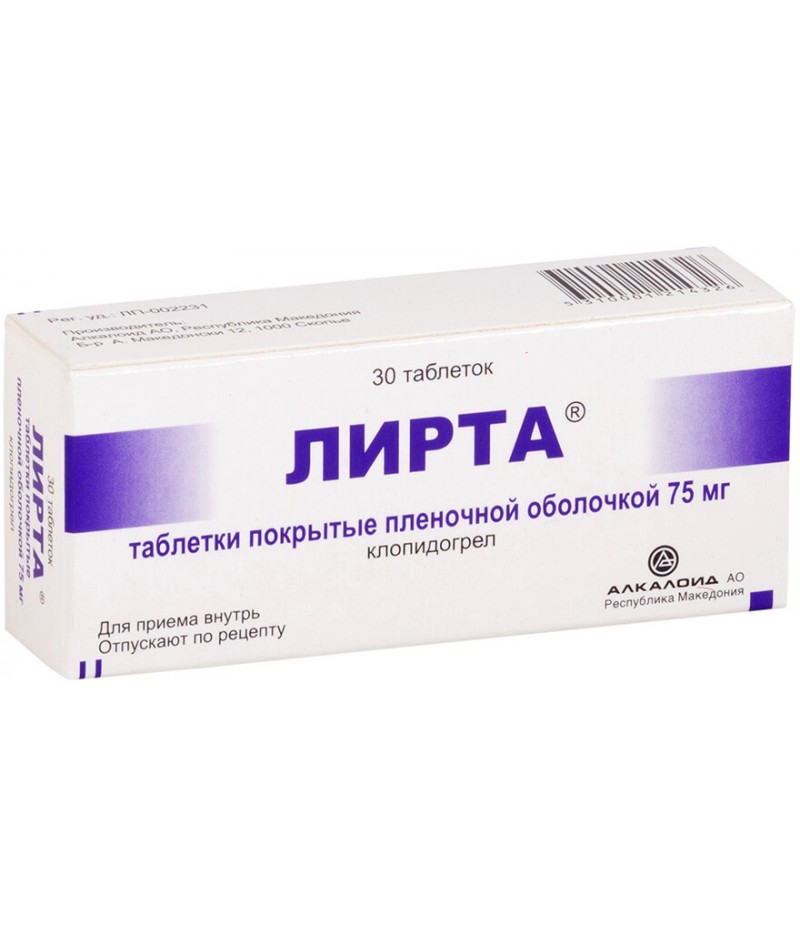Clopidex tabs 75mg #30
- $30.18
- 3 or more $29.85
- Availability:In Stock
Clopidex instruction for useYou can buy Clopidex hereCompositionOne tablet, film coated, contains the active substance:clopidogrel (in the form of clopidogrel form I hydrosulfate) - 75.00 mg;excipients: hyprolosis - 6.125 mg, mann..
Tags: tabs
Clopidex instruction for use
You can buy Clopidex here
Composition
One tablet, film coated, contains the active substance:
clopidogrel (in the form of clopidogrel form I hydrosulfate) - 75.00 mg;
excipients: hyprolosis - 6.125 mg, mannitol - 120.175 mg, microcrystalline cellulose - 17.150 mg, macrogol-6000 - 2.450 mg, hydrogenated castor oil - 1.225 mg;
tablet shell: opadra pink (lactose monohydrate - 2.800 mg, hypromellose (15 CPS) - 1.921 mg, titanium dioxide (E171) -1.656 mg, triacetin - 0.560 mg, iron red oxide (E172) - 0.063 mg) - 7,000 mg.
Description
Round, biconvex tablets, film-coated light pink color.
Pharmacotherapeutic group
Antiplatelet agent
ATX Code [B01AC04]
Pharmacological properties
Pharmacodynamics
Clopidogrel is a prodrug, one of the active metabolites of which is an inhibitor of platelet aggregation. The active metabolite of clopidogrel selectively inhibits the binding of adenosine diphosphate (ADP) to its platelet receptor and the subsequent ADP-mediated activation of GPIIb / IIIa complex, leading to the suppression of platelet aggregation.
Due to irreversible binding, platelets remain insensitive to stimulation of ADP for the remainder of their life (approximately 7-10 days), and restoration of normal platelet function occurs at a rate corresponding to the rate of platelet renewal.
Platelet aggregation, caused by agonists other than ADP, is also inhibited due to blockade of enhanced platelet activation by released ADP.
Since the formation of an active metabolite occurs with the help of enzymes of the P450 system, some of which may differ in polymorphism or may be inhibited by other drugs, not all patients can adequately suppress platelets. Clopidogrel can prevent the development of atherothrombosis in any localization of atherosclerotic vascular lesions. In particular, with lesions of cerebral, coronary or peripheral arteries. With daily intake of clopidogrel in a dose of 75 mg from the first day of administration, a significant suppression of ADP-induced platelet aggregation is observed, which gradually increases over 3-7 days and then goes to a constant level (when an equilibrium state is reached). In equilibrium, platelet aggregation is suppressed on average by 40-60%. After discontinuation of clopidogrel, platelet aggregation and bleeding time gradually return to the initial level, usually within 5 days.
Pharmacokinetics
Suction
After oral administration at a dose of 75 mg per day, it is rapidly absorbed, characterized by high absorption and bioavailability. However, the concentration of the initial substance in the plasma is low and 2 hours after administration it does not reach the measurement limit (0.025 μg / l).
According to the renal secretion of clopidogrel metabolites, absorption is about 50%.
Distribution
In vitro clopidogrel and its major inactive metabolite circulating in the blood bind reversibly to plasma proteins, by 98% and 94%, respectively.
Metabolism
Clopidogrel is actively metabolized in the liver, and the main metabolite, an inactive carboxylic acid derivative, is about 85% of the substance circulating in the blood plasma. The time to reach the maximum concentration (TCmax) of this metabolite (Cmax - about 3 mg / l after repeated oral administration at a dose of 75 mg) is reached 1 hour after oral administration.
The active metabolite, the thiol derivative of clopidogrel, is formed by oxidizing clopidogrel to 2-oxo-clopidogrel and subsequent hydrolysis. In vitro, this metabolic pathway occurs with the help of the isoenzymes P450, CYP2C19, CYP1A2 and CYP2B6. The active thiol metabolite of clopidogrel, isolated in vitro, rapidly and irreversibly binds to platelet receptors, blocking platelet aggregation.
Removal
About 50% of Clopidex is excreted by the kidneys and about 46% by the intestines within 120 hours after ingestion. After a single oral dose of 75 mg, the half-life (T1 / 2) of clopidogrel is approximately 6 hours. The half-life of the main circulating inactive metabolite after a single dose and repeated use is 8 hours.
The concentration of the main circulating metabolite in plasma after administration of 75 mg per day in patients with severe chronic renal failure (creatinine clearance (CK) from 5 to 15 ml / min) is lower compared to patients with chronic renal failure of moderate severity (CC from 30 to 60 ml / min) and healthy volunteers. Although inhibition of ADP-induced platelet aggregation in patients with renal insufficiency was also lower than in healthy volunteers, the lengthening of bleeding time was the same as in healthy volunteers who took 75 mg of clopidogrel per day. In addition, clinical tolerance was good in all patients.
In patients with liver cirrhosis, clopidogrel in a daily dose of 75 mg for 10 days was safe and well tolerated. Сmax of clopidogrel with single and repeated use in patients with cirrhosis was significantly higher than in healthy volunteers. However, plasma concentrations of the main circulating metabolite and ADP-induced platelet aggregation, as well as bleeding time, were comparable in both groups.
Pharmacogenetics
Several polymorphic enzymes of the P450 system are involved in the activation of clopidogrel. Isoenzyme SUR2S19 is involved in the formation of both the active metabolite and the intermediate metabolite, 2-oxoclopidogrel. The pharmacokinetics and antiplatelet effects of the active metabolite of clopidogrel, studied by ex vivo platelet aggregation, differ depending on the genotype of the CYP2C19 isoenzyme. The allele of the CYP2C19 * 1 gene is responsible for a normally functioning metabolism, whereas the allele of the CYP2C19 * 2 isoenzyme and CYP2C19 * 3 isoenzyme are responsible for reduced metabolism. These alleles are responsible for a decrease in metabolism in approximately 85% of Caucasians and in 99% of those of the Mongoloid race. Other alleles associated with reduced metabolism are represented by CYP2C19 * 4, * 5, * 6, * 7 and * 8 isoenzymes, but they are rarely found in the general population.
Selected patient groups
The pharmacokinetics of the active metabolite of clopidogrel in individual groups of patients has not been studied.
Elderly age
There were no differences in the platelet aggregation and bleeding time between the elderly (over 75 years old) and young volunteers. Dose adjustment for elderly people is not required.
Renal dysfunction
After repeated doses of clopidogrel at a dose of 75 mg / day in patients with severe renal dysfunction (CK from 5 to 15 ml / min), inhibition of ADP-induced platelet aggregation is 25% lower than in healthy volunteers; lengthening the bleeding time equally in comparison with healthy volunteers who took 75 mg of clopidogrel per day.
Liver dysfunction
The average bleeding time and inhibition of ADP-induced aggregation when using clopidogrel in a dose of 75 mg / day for 10 days in patients with severe liver damage is comparable to healthy volunteers.
Indications for use of Clopidex
Prevention of atherothrombotic events in patients after myocardial infarction, ischemic stroke or diagnosed with occlusive peripheral artery disease.
Prevention of atherothrombotic events (in combination with acetylsalicylic acid (ASK)) in patients with acute coronary syndrome:
without ST-segment elevation (unstable angina or non-Q wave myocardial infarction), including patients who underwent stenting for percutaneous coronary intervention;
with ST segment elevation (acute myocardial infarction) with drug treatment and the possibility of thrombolytic therapy.
Prevention of atherothrombotic and thromboembolic complications, including stroke, in atrial fibrillation (atrial fibrillation). In patients with atrial fibrillation (atrial fibrillation), who have at least one risk factor for the development of vascular complications, indirect anticoagulants cannot be taken and have a low risk of bleeding (in combination with acetylsalicylic acid).
Contraindications
Hypersensitivity; lactose intolerance, lactase deficiency and glucose-galactose malabsorption syndrome; severe liver failure; acute bleeding (including peptic ulcer or intracranial hemorrhage); pregnancy and lactation; children's age up to 18 years.
Carefully
Moderate liver failure, chronic renal failure (CRF), pathological conditions that increase the risk of bleeding (including trauma, surgery), bleeding tendency, simultaneous use of ASA, warfarin, nonsteroidal anti-inflammatory drugs (NSAIDs) (including selective inhibitors COX-2), heparin, glycoprotein IIb / IIIa inhibitors, hereditary decrease in CYP2C19 function.
Use during pregnancy and during breastfeeding
Pregnancy
Since there are no clinical data on the use of Clopidex during pregnancy, the use of clopidogrel in pregnant women is not recommended. The drug can be applied during pregnancy only when the benefit to the mother outweighs the potential risk to the fetus.
Animal trials do not indicate direct or indirect adverse effects on the course of pregnancy, fetal development, childbirth and postnatal development.
Breast-feeding
If clopidogrel therapy is needed, breastfeeding should be discontinued, since rat tests have shown that clopidogrel and / or its metabolites are excreted into breast milk. Data on the penetration of clopidogrel into human breast milk are not known.
Dosage and administration
Inside, regardless of the meal.
For the prevention of atherothrombotic events in patients with myocardial infarction, ischemic stroke or diagnosed occlusion of peripheral arteries - 75 mg 1 time per day. In patients with myocardial infarction, treatment should begin from the first days to the 35th day of myocardial infarction, and in patients with ischemic stroke - from 7 days to 6 months after ischemic stroke.
To prevent atherothrombotic events in acute coronary syndrome without ST-segment elevation (unstable angina, myocardial infarction without Q wave), start with a single dose of 300 mg and then take 75 mg per day (in combination with ASA in doses of 75 325 mg per day, recommended dose - 100 mg per day). The maximum beneficial effect occurs after 3 months. The course of treatment up to 1 year.
To prevent atherothrombotic events in acute coronary syndrome with ST segment elevation (acute myocardial infarction with ST segment elevation) - 75 mg per day with an initial single dose of the loading dose in combination with ASA and thrombolytic (or without thrombolytic).
Combination therapy is started as soon as possible after the onset of symptoms and continues for at least 4 weeks. In patients older than 75 years, treatment with clopidogrel must begin without taking its loading dose.
In patients with a genetically determined decrease in the function of the isoenzyme CYP2C19, the effect of clopidogrel may be reduced. The optimal dosing regimen in these patients has not been established.
Experience of use in patients with chronic renal failure or moderate liver failure is limited.
Side effect of Clopidex
The frequency of side effects is determined according to the following definitions: very often - more than 1/10, often - more than 1/100 and less than 1/10, infrequently - more than 1/1000 and less than 1/100, rarely - more than 1/10000 and less than 1 / 1000, very rarely - less than 1/10000, including isolated cases.
The most common reaction is bleeding, which occurs during the first month of taking Clopidex. Cases of severe bleeding have been reported in patients taking clopidogrel simultaneously with ASA or clopidogrel with ASA and heparin.
From the side of blood-forming organs: infrequently - thrombocytopenia, leukopenia, eosinophilia; seldom - neutropenia, including severe; very rarely, thrombotic thrombocytopenic purpura, anemia, including aplastic, pancytopenia, agranulocytosis, severe thrombocytopenia, granulocytopenia.
On the part of the nervous system: infrequently - headache, dizziness, paresthesias, intracranial bleeding, including fatal; very rarely, mental confusion, hallucinations, taste disturbance.
From the senses: infrequently - hemorrhage in the conjunctiva, eyes, retina; rarely - vertigo.
Since the cardiovascular system: often - hematoma; very rarely - severe bleeding, bleeding from the surgical wound, vasculitis, lowering blood pressure.
On the part of the respiratory system: very often - nosebleeds; very rarely - bronchospasm, interstitial pneumonitis, pulmonary hemorrhage, hemoptysis.
On the part of the digestive system: often - diarrhea, abdominal pain, dyspepsia, bleeding from the gastrointestinal tract; infrequently - gastric and duodenal ulcers, gastritis, vomiting, nausea, constipation, flatulence; rarely retroperitoneal bleeding; very rarely - pancreatitis, colitis, including ulcerative or lymphocytic, stomatitis, acute liver failure, hepatitis, impaired liver function tests, bleeding from the gastrointestinal tract with a fatal outcome.
On the part of the skin: often - subcutaneous hemorrhage; infrequently - skin rash, itching, purpura; very rarely - angioedema, urticaria, erythematous rash, erythema multiforme, Stevens-Johnson syndrome, toxic epidermal necrolysis, eczema, lichen planus.
On the part of the musculoskeletal system: very rarely - hemarthrosis, arthritis, arthralgia, myalgia.
From the genitourinary system: infrequently - hematuria; very rarely glomerulonephritis, hypercreatininemia.
Allergic reactions: very rarely - anaphylactic reactions, serum sickness.
Laboratory indicators: infrequently - lengthening of bleeding time.
Other: very rarely - fever.
Overdose
Symptoms: possible lengthening of bleeding time and subsequent complications in the form of bleeding.
Treatment: stop bleeding, platelet transfusions.
Interaction with other drugs
The simultaneous use of clopidogrel and warfarin is not recommended due to the increased risk of bleeding.
The prescription of glycoprotein Ilb / IIIa inhibitors together with clopidogrel increases the risk of bleeding, so caution is advised when using them simultaneously.
ASK does not alter the inhibitory effect of clopidogrel on ADP induced platelet aggregation, but clopidogrel enhances the effect of ASA on collagen-induced platelet aggregation. The combined use of these drugs requires caution. However, in patients with acute coronary syndrome without ST-segment elevation, long-term combined use of clopidogrel and ASA is recommended (up to 1 year).
With simultaneous use with NSAIDs, the risk of bleeding may increase, so care should be taken when using them simultaneously.
Simultaneous administration with inhibitors of CYP2C19 (for example, omeprazole) is not recommended.
The active metabolite of clopidorgel inhibits the activity of the CYP2C9 isoenzyme, as a result of which the concentrations of phenytoin, tolbutamide and NSAIDs in the blood plasma may increase.
Numerous clinical studies have not revealed significant clinical interactions with the simultaneous administration of clopidogrel and such drugs as atenolol, ACE inhibitors, cholesterol-lowering drugs, nifedipine, digoxin, phenobarbital, cimetidine, estrogen, theophylline.
Antacids do not affect clopidogrel absorption.
special instructions
During the treatment period, it is necessary to monitor the indicators of the hemostatic system (activated partial thromboplastin time (APTT), platelet count, tests of the functional activity of platelets); regularly examine the functional activity of the liver.
Clopidogrel should be used with caution in patients with a risk of severe bleeding associated with injuries, surgical interventions, in patients with lesions prone to bleeding (especially gastrointestinal and intraocular), as well as in patients receiving ASA, nonsteroidal anti-inflammatory drugs (in including COX-2), heparin or glycoprotein IIb / Sha inhibitors. Patients should be carefully monitored to detect any signs of bleeding, including latent, especially during the first weeks of use of Clopidex and / or after invasive heart procedures or surgeries.
Simultaneous use of clopidogrel and warfarin can increase the intensity of bleeding, therefore, with the exception of special rare clinical situations (such as the presence of a floating thrombus in the left ventricle, stenting in patients with atrial fibrillation), combined use with warfarin is not recommended.
In the case of surgical interventions, if the antiplatelet effect is undesirable, the treatment should be stopped 7 days before the operation.
Patients should be warned that when taking clopidogrel (alone or in combination with ASA), it may take longer to stop the bleeding, and that if they have unusual (localization or duration) bleeding, they should be informed about this doctor. Patients should also inform the doctor about taking Clopidex if they are to undergo surgery (including dental).
Very rarely, thrombotic thrombocytopenic purpura (TTP) developed with clopidogrel, sometimes after short-term use. This condition is characterized by thrombocytopenia and microangiopathic hemolytic anemia in combination with neurological signs, kidney damage and fever. Thrombotic thrombocytopenic purpura is a potentially life-threatening condition that requires immediate treatment, including plasmapheresis.
Due to the lack of data, it is not recommended to prescribe clopidogrel to patients with acute ischemic stroke less than 7 days old.
In severe hepatic impairment, the risk of hemorrhagic diathesis should be kept in mind; therefore, these patients should be carefully prescribed clopidogrel due to limited experience with Clopidex in these patients.
Experience with clopidogrel in patients with impaired renal function is limited, so these patients should be prescribed clopidogrel with caution. Dosage forms containing hydrogenated castor oil can cause dyspepsia and diarrhea.
Clopidex contains lactose, so you should not use Clopidex in patients with hereditary galactase intolerance, lactase deficiency or malabsorption syndrome of glucose and galactase. Impact on the ability to drive vehicles and mechanisms
Clopidogrel does not affect the ability to drive vehicles and mechanisms.
Release form
Tablets, film coated 75 mg
On 15 tablets in PVC / PVDH // Al blister. 2 blisters together with instructions for use are placed in a cardboard box.
Storage conditions
At a temperature not higher than 25 ° С.
Keep out of reach of children!
Expiration date 2 years.
Do not use after the expiration date.
Terms of sell
You can buy Clopidex withou a prescription.

